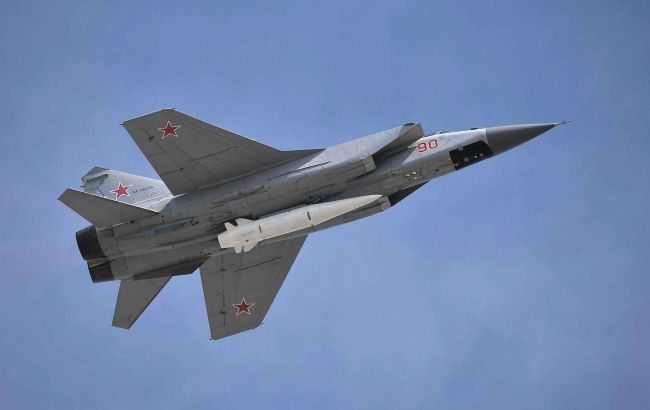Russian Kinzhal missile attacks test Ukraine's air defenses and strategic resilience
 Photo: MiG-31K fighter jet armed with a Kinzhal missile (wikipedia.org)
Photo: MiG-31K fighter jet armed with a Kinzhal missile (wikipedia.org)
Russian forces have recently been actively using the air-launched Kinzhal X-47M2 hypersonic missile to attack Kyiv, Starokostiantyniv, Khmelnytskyi region, and several other Ukrainian cities. This is an aero-ballistic missile with extremely high speed. It is very difficult to intercept with air defense systems.
RBC-Ukraine reports what is known about this Russian weapon of terror.
When did it first appear?
The air-launched Kinzhal missile was first shown in March 2018, although it officially entered service in December 2017. The missile can carry a nuclear warhead, placing it in the strategic category. Its development was based on the Iskander-M ballistic missile.
As carriers of the missile, the Russians announced strategic bombers Tu-22M3 and MiG-31K fighters. However, since August 2022, the MiG-31K has been selected as the sole carrier. There is also consideration to adapt the newest Su-57 fighters as carriers.
Active use of the Kinzhal missiles in the full-scale invasion of Ukraine began in March 2022. At that time, the occupiers claimed they struck Deliatyn, Ivano-Frankivsk region, with Kinzhal missiles, which the Ukrainian side did not confirm. The occupiers equip the Kinzhal missiles with a BetAB-type warhead (concrete-piercing bunker buster).
Is the Kinzhal really a hypersonic missile?
During the missile's 2018 presentation, the Russians promoted it as a kind of "miracle weapon." They claimed the Kinzhal is hypersonic, reaching speeds from Mach 10 to Mach 13 (10 to 13 times the speed of sound). However, experience showed that the Kremlin lied. The missile is aero-ballistic, not truly hypersonic.
Hypersonic weapons are missiles whose warheads can reach speeds from 5,000 to 25,000 kilometers per hour while traveling within the atmosphere. The speed of most ballistic missiles in their terminal phase exceeds 5,000 km/h. The Kinzhal reaches speeds around 10,000 km/h but cannot maintain this speed constantly.
Specifications and production rates
The Russians claim the following specs for the Kinzhal:
- Weight: 4,300 kg;
- Length / Width: 7.2 meters / 1.2 meters;
- Engine: solid-fuel rocket;
- Operational range: up to 2,000 km (including the launch aircraft’s range);
- Claimed speed: Mach 10 to Mach 13 (12,250 km/h to 15,900 km/h).
According to the Defense Intelligence of the Ministry of Defense of Ukraine, Russian defense production can manufacture 10 to 15 X-47M2 missiles per month. This is due to established sanction evasion schemes and "gray imports."
According to Ukrainian intelligence, the current Kremlin stockpile of Kinzhal missiles is estimated to be 100-150 units. The recent increase in attacks with this missile may be related to this stockpile.
How long does the Kinzhal take to reach cities in Ukraine?
The X-47M2 travels at a very high speed and has a very short flight time to Ukrainian cities. It is measured in minutes when launched from central Russia or tens of minutes when launched by a MiG-31K from Russian Astrakhan.
Most often, MiGs take off from the Savasleyka airfield in the Nizhny Novgorod region of Russia and launch the X-47M2 over the Lipetsk region. In this case, the missile’s flight time is approximately:
- To Kyiv: 3.2 minutes
- To Vinnytsia: 4.1 minutes
- To Chernihiv: 2.7 minutes
- To Kharkiv: 1.7 minutes
- To Poltava: 2.4 minutes
- To Dnipro: 2.7 minutes
- To Odesa: 4.5 minutes
- To Lviv: 5.4 minutes
- To Zaporizhzhia: 2.9 minutes
- To Uzhhorod: 6.3 minutes
- To Starokostiantyniv: 4.4 minutes
Can the Kinzhal be shot down?
Before the full-scale invasion, the Russians claimed the X-47M2 was supposedly impossible to shoot down because it retains maneuverability at its high speeds.
This also turned out to be false. The missile is hard to shoot down, but it is definitely possible, especially for Western systems. In 2022 and the first half of 2023, Ukraine was unable to intercept Kinzhal missiles due to a lack of proper air defense systems. Soviet S-300 systems are unable to intercept such targets.
With the delivery of Patriot air defense systems from the US, equipped with PAC-2 and PAC-3 missiles, the situation changed drastically. The first Kinzhal was intercepted on May 4, 2023. Since then, the number of shot-down Russian "miracle missiles" has increased.
As of now, the majority of X-47M2 missiles fired by Russia have been intercepted. In June 2025, the spokesperson for the Ukrainian Air Forces, Yurii Ihnat, reported that 8 out of 17 Kinzhal missiles were shot down. Some of the remaining nine were lost due to targeting failures (the missile missed its target and fell).
Theoretically, in addition to Patriot, the Franco-Italian SAMP/T air defense system can also intercept Kinzhal missiles. Ukraine operates such systems, and its Aster 30 Block 1 missiles are comparable to American PAC-3 missiles. However, there have been no confirmed interceptions of Kinzhal missiles by SAMP/T systems.
As a reminder, after the conversation between US President Donald Trump and Ukrainian President Volodymyr Zelenskyy, the American leader confirmed that Washington is considering providing Kyiv with additional missiles for Patriot air defense systems.
This conversation took place amid the halt of weapons supplies to Ukraine from the US. In particular, this decision affected missiles for the Patriot system — arguably the only air defense system capable of shooting down Kinzhal missiles.

